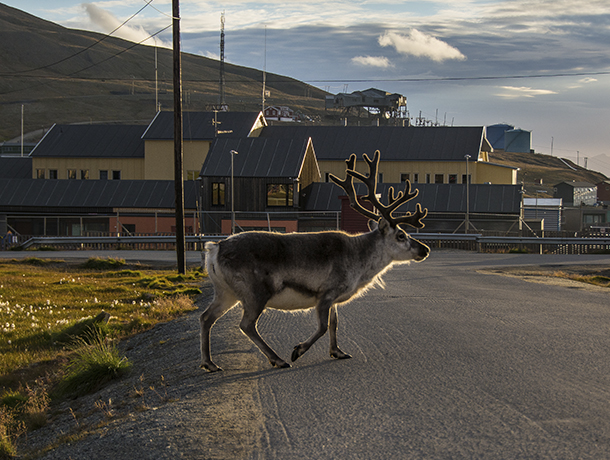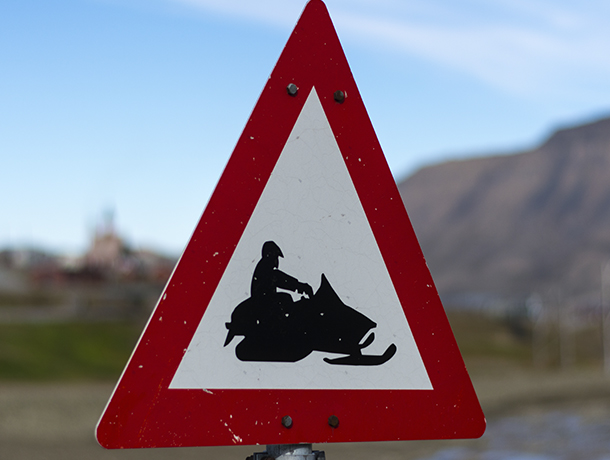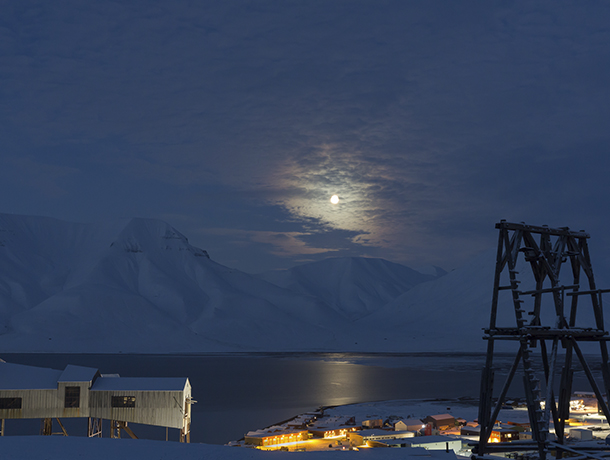
Longyearbyen
Where the extraordinary is ordinary
Longyearbyen, the administrative centre of Svalbard, is a tiny Norwegian metropolis with 2,100 residents from almost 50 different countries. The small Arctic town is inhabited by nature enthusiasts who live in close unity under tough climatic conditions with the High Arctic wilderness right on their doorstep. Longyearbyen is the gateway to the nature-based experiences and the starting point for most adventures in Svalbard. This Arctic wilderness starts virtually in the town centre and never ends!
Maybe it seems a bit over the top to call our little town a metropolis. However, with its vitality, international vibe and warm people in wonderful surroundings, that’s exactly how we perceive it. Longyearbyen’s central location in a geopolitically interesting Arctic also contributes to it being perceived as larger than it actually is. Furthermore, the range of services on offer to residents and guests is surprisingly extensive with a wide range of shops, restaurants and bars, along with varied cultural offerings. In Longyearbyen, the North Pole is right around the corner from the pub. Perhaps some find it strange that a settlement so incredibly far north has its own brewery, chocolaterie and greenhouse that supplies us with fresh herbs and vegetables, but that’s just the way it is!
 A slightly different town
A slightly different town
Although the tiny metropolis may appear a bit “harsh” with a rough industrial exterior, Longyearbyen is renowned for its hospitality and high level of comfort. Most people enjoy themselves in Longyearbyen and quickly feel they belong here. Many are bitten by the “Arctic bug” and refuse to move southwards. “I only planned to be here for one year, but I’ve been here for many years now,” is a comment you hear virtually every day. Nevertheless, Longyearbyen is a place people come to work and not somewhere they can spend their entire lives. The average time people live in Svalbard is seven years, according to Statistics Norway.
The residents of Longyearbyen feel that we live completely normal everyday lives. However, those looking from the outside often perceive our everyday life as somewhat extraordinary. The polar bears are never far away, so it’s a necessity to carry weapons when we venture outside the settlement. The climate is harsh and unpredictable. Some people find the contrasts and changes between light and dark challenging, while others think it’s wonderful.
 There are several other things about Longyearbyen that may seem “strange” to visitors. There are separate “roads” in the town centre for snowmobiles, we only have one grocery store and we are used to living next door to reindeer. We still take off our shoes when we enter hotels and restaurants, a tradition that has arisen from the problem with coal dust in the old days. All the mining infrastructure is protected and remains as surreal monuments in and around the settlement. The streets in Longyearbyen have numbers instead of names. Longyearbyen has a university centre with 300 students, all of whom must learn to use firearms. Seeing whales swimming in the fjord from our lounge window is not an uncommon occurrence.
There are several other things about Longyearbyen that may seem “strange” to visitors. There are separate “roads” in the town centre for snowmobiles, we only have one grocery store and we are used to living next door to reindeer. We still take off our shoes when we enter hotels and restaurants, a tradition that has arisen from the problem with coal dust in the old days. All the mining infrastructure is protected and remains as surreal monuments in and around the settlement. The streets in Longyearbyen have numbers instead of names. Longyearbyen has a university centre with 300 students, all of whom must learn to use firearms. Seeing whales swimming in the fjord from our lounge window is not an uncommon occurrence.
We gladly have a beer with our colleagues outside after work while wearing mittens. During the winter darkness, we wear a headlamp on our way to work, and it’s not uncommon to see the Northern Lights dancing in the sky when we head outside to meet a friend for lunch. In the summertime, you often go out with the Midnight Sun shining brightly on your face. Longyearbyen is home to around 1,000 eager polar dogs who will gladly take you out into the wilderness, while the toughest residents are members of the local snowmobile club, Sons of Svalbard. One thing we really enjoy is packing our snowmobile sleds after work on Fridays and setting off on weekend trips in the Arctic wilderness with our family or friends.
 Spectacular location
Spectacular location
Longyearbyen is situated in a valley on the shores of the idyllic Adventfjord, surrounded by steep mountains and several glaciers. There are only around 40 km of roads in Longyearbyen, which is divided into several “suburbs”, including the town centre and Nybyen (new town). Most of the hotels, restaurants, pubs and shops are in the town centre. Nybyen, which is located 2 km south of town, consists of charming miners’ barracks constructed after the war, as well as guest houses, a restaurant and gallery, not to mention beautiful views of the landmark mountain, Hiorthfjellet. Midway between the town centre and Nybyen are the restaurants Gruvelageret and Huset. The latter has an impressive wine cellar and is one of Norway’s best restaurants.
Longyearbyen is located at latitude 78° North – just 1,316 km from the North Pole. Longyearbyen is a three-hour flight from Oslo or a 90-minute flight from Tromsø. Longyearbyen is situated on the island of Spitsbergen, the largest island in the Svalbard archipelago. While Longyearbyen is the world’s northernmost settlement with a permanent population of more than 1,000, Svalbard has another settlement even further north – the research station of Ny-Ålesund.
.jpg) What do the locals live by?
What do the locals live by?
Longyearbyen exists because of the coal in the mountains, and has been built by the mining industry over the past century. Longyearbyen was a typical mining town up to 1990, but has now evolved into a town with a varied business community. Mining remains one of the main industries, but owing to falling coal prices in recent years the mining operations have been scaled down. The State-owned mining company, Store Norske Spitsbergen Kullkompani, still operates a coal mine near Longyearbyen, Mine 7, up the valley of Adventdalen.
After the 1990s, tourism has slowly but surely become a major industry in Longyearbyen, and is now one of the main pillars of society. In 2016, 115,000 tourists visited Longyearbyen, of which 35,000 arrived by cruise ship from overseas.
Research and education is another important industry. Students from all over the world come to study at the University Centre in Svalbard (UNIS), which focuses on Arctic research in the fields of biology, geology, geophysics and technology.
Longyearbyen also has support functions every community is reliant on, such as a hospital, school, kindergartens, sports hall, church and cultural centre.
The seasons of Longyearbyen
Most residents of Longyearbyen agree that each season has its own charm. Some prefer the Northern Lights winter, while others appreciate the brighter sunny season when the Midnight Sun is high in the polar sky.
During the Northern Lights winter, it is dark in Svalbard four months. For a two-and-a-half-month period it’s completely dark with no difference between day and night. The Polar Night, as this period is known, starts and finishes with spectacular “twilight” when the “blue hour” lasts all day long. Although the sun remains below the horizon, it sends beautiful blue and red rays up onto the polar sky. The polar summer, on the other hand, is dominated by the Midnight Sun, which is high in the sky 24/7.
 The huge seasonal contrasts leave their mark on Longyearbyen, where the activities and everyday life are controlled by the season. When it’s bright and sunny, people spend a lot of time outdoors, while Longyearbyen has a different pulse during the winter darkness when the locals and guests alike are extra sociable. During this period, we enjoy meeting one another at festivals, concerts, sporting events or over a delicious dinner in one of the town’s many restaurants. Heading up into the mountains with a headlamp or participating in the torchlit parade at Christmas are also wonderful traditions among the locals during the dark season.
The huge seasonal contrasts leave their mark on Longyearbyen, where the activities and everyday life are controlled by the season. When it’s bright and sunny, people spend a lot of time outdoors, while Longyearbyen has a different pulse during the winter darkness when the locals and guests alike are extra sociable. During this period, we enjoy meeting one another at festivals, concerts, sporting events or over a delicious dinner in one of the town’s many restaurants. Heading up into the mountains with a headlamp or participating in the torchlit parade at Christmas are also wonderful traditions among the locals during the dark season.
The rich history of Longyearbyen and Svalbard
Svalbardi literally means “the land with the cold shores”. Svalbarði fundinn was mentioned in traditional Icelandic accounts dated to 1194. However, we will never know for sure whether this mention refers to the discovery of Svalbard or another land area with cold shores.
The first undisputed discovery of the archipelago was an expedition led by Dutch explorer Willem Barentsz in 1596, during which he called the largest island Spitsbergen (“pointed mountains” in Dutch) after the mountains on the western side of the island. Ever since that time, Svalbard has given rise to legendary stories about hunting, trapping, mining and incredible expeditions. Svalbard’s history has included international whaling (1600-1750), Russian overwintering hunting and trapping (1700-1850) and Norwegian overwintering hunting and trapping (1850-1973).
In 1906, the American businessman and mining pioneer John Munroe Longyear established the first mine, erected buildings and named the settlement Longyear City. Longyear had visited Svalbard for the first time as a cruise passenger in 1901. In 1916, the Store Norske Spitsbergen Kullkompani took over the mining operations from Longyear’s Arctic Coal Company, and the settlement was renamed Longyearbyen.
The Svalbard Treaty was signed on 9 February 1920 and entered into force on 14 August 1925. The treaty was ratified by The Netherlands, the United Kingdom, Denmark, USA, Italy, France, Sweden, Norway and Japan. It was later ratified by many other countries, including the Soviet Union (Russia) and Canada. There are now 44 parties to the treaty. “The Svalbard Treaty recognises Norwegian sovereignty over Svalbard, including Bjørnøya (Bear Island), and that Norwegian law applies within the archipelago. The treaty also provides certain rights for the other signatories, including that their citizens may reside and engage in business activities, hunting and fishing in the archipelago. Furthermore, the treaty regulates the demilitarisation of the archipelago, i.e. fortresses, naval bases and the stationing of military personnel are not permitted.” Source: https://snl.no/Svalbardtraktaten
.jpg) Longyearbyen was a company town until 1989. The mining company Store Norske Spitsbergen Kullkompani (which was nationalised in 1976) controlled most of the infrastructure and services. In line with a White Paper from the Norwegian government in 1990, the authorities started a process to “normalise” Longyearbyen into a more open and regular community. This included the establishment of the Svalbard Council, which was replaced in 2002 by the expanded Longyearbyen Community Council (Longyearbyen Lokalstyre) based on a model adapted for the settlement’s endemic conditions. This coincided with the transferring of responsibility for community services and governance duties from the mining company to the Longyearbyen Community Council. In many areas, the community now functions like a municipality on the mainland, although naturally there are some significant differences.
Longyearbyen was a company town until 1989. The mining company Store Norske Spitsbergen Kullkompani (which was nationalised in 1976) controlled most of the infrastructure and services. In line with a White Paper from the Norwegian government in 1990, the authorities started a process to “normalise” Longyearbyen into a more open and regular community. This included the establishment of the Svalbard Council, which was replaced in 2002 by the expanded Longyearbyen Community Council (Longyearbyen Lokalstyre) based on a model adapted for the settlement’s endemic conditions. This coincided with the transferring of responsibility for community services and governance duties from the mining company to the Longyearbyen Community Council. In many areas, the community now functions like a municipality on the mainland, although naturally there are some significant differences.
Svalbard is not a place people spend their entire lives or where families are continued through generations, although there are a few family generations here. People have generally come and gone, contributing to Svalbard’s distinctive history. Consequently, it has been harder for the people to take advantage of the accumulated experience of the harsh and extreme living conditions. The history of Svalbard is rich in tragic events, and graves are the most common relics of culture.
Source: Visit Svalbard